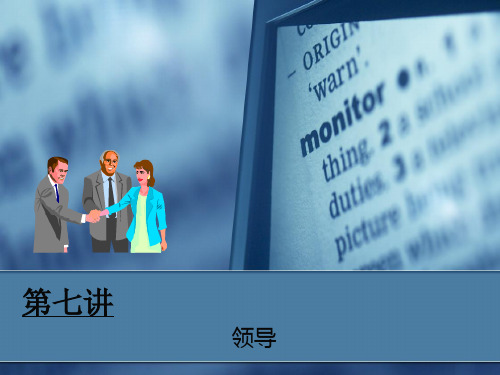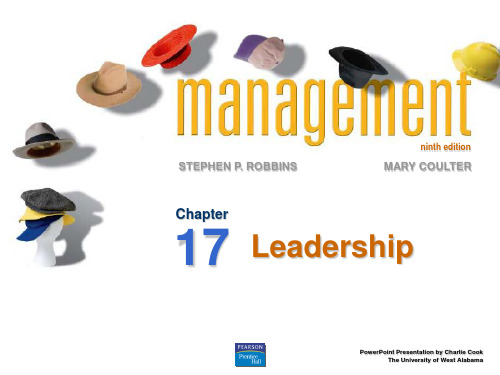管理学课件 第17章 领导Leadership
管理学-领导PPT课件

从领导实践看,影响力从低到高大致可分为四个层次。一种 是当部属提及某位领导时,不是摇头叹息,就是嗤之以鼻,可 谓“厌而恶之”。一种是部属对领导的才华很钦佩,但不太愿 意接近他,常常是“敬而远之”。一种是部属不仅愿意接近他, 而且把他引为知己,可谓“亲而近之”。还有一种是虽然与部 属不常谋面,但部属心里始终有他,即使离任后大家还在赞誉 他、念着他的好,可谓“怀而念之”。显然,后两个层次,是 影响力的较高境界。
非职权影响力
法
强
奖
专
感
定
制
赏
长
召
权
权
权
权
权
强制权
领导者 职位 方面
下属 恐惧 方面
奖赏权 法定权 感召权
职位
职位 个人魅力
专长权
个人专长
欲望
习惯观念 信任
尊敬
现代社会,领导者确立威信、影响下级,不仅靠“硬”权 力,还越来越多地靠“软”权力,也就是非权力影响力。
为什么有的领导干部手握重权,却有权无威、下属 “不买账”、群众不支持?原因很简单,权力可以使人敬畏, 却未必能让人拥戴。因此,提升非权力影响力,不容小觑。
总结
• 从本质上说,建立基础不同:
– 管理是建立在合法的、有报酬的和强制性的权力基 础上的;
– 领导可能是建立在合法的、有报酬的和强制性权力 基础上的,但更多的是建立在个人影响力、专长权 及模范作用等基础上的。
• 领导者不一定是管理者,但管理者应该成为领 导者。
• 管理学探讨的是:管理者如何成为领导者。
传统观念:组织赋予一个人职位和权力,以率领其 下属实现组织目标。
现代观念:认为是一种影响力,是对人们施加影响, 从而使人们心甘情愿地为实现组织目标而努力的艺术 过程。
leadership领导力 ppt课件

leadership领导力 ppt课件
6
1.Tannenbaum and Schmidt continuum 2.Rensis Likert Support Relation Theory 3.Chris Argyris Immature – Mature continuum 4. Blake and Mouton Managerial Grid 5.John Adair Action Centred Leadership
2. Autocratic 2 (A2) – you ask team members for specific information and once you have it, you make the decision. Here you don't necessarily tell them what the information is needed for. .
2021/3/26
leadership领导力 ppt课件
27
管理者的两种类型:
1. 任务导向型:task oriented 2. 人员导向型:relationship oriented
衡量管理情况的三个维度:
1.Position and authority 领导者的权利和地位 2.Objective structure 任务结构
Contigency Theory
三选一
2021/3/26
leadership领导力 ppt课件
26
1.Fiedler’s Contingency Theory 菲德勒的权变管理思想
中心思想:不同管理(situation)情况适用 不同领导风格(leadership behaviour)—— 把人放进情况里
《管理学基础》第十七章领导

PPT文档演模板
《管理学基础》第十七章领导
权变的领导理论
• 费德勒模型
Ø 指出有效的群体绩效取决于两个方面的恰当匹配: v 与下属发生相互作用的领导风格 v 领导者能够控制和影响情境的程度
Ø 假设: v 不同情形下,总有一种领导模式是最有效的 v 领导者不会真正改变领导风格
– 选择领导者以适应情境 – 改变情境以适应领导者
影响群体实现目标的过程 • 理论上说,所有的管理者都应成为领导者 • 尽管组织中可能出现非正式的领导者,但这些不是我
们研究的领导者
领导研究旨在回答:什么是有效的领导者?
PPT文档演模板
《管理学基础》第十七章领导
早期的领导理论
• 特质理论 (1920s-30s)
Ø 研究关注领导者的特质,也就是那些能把领导者从非 领导者中区分出来的个性特点,但不很成功
PPT文档演模板
《管理学基础》第十七章领导
领导有关的最新观点(续)
• 团队领导
Ø 有耐心去分享信息 Ø 信任他人并放弃自己的职权 Ø 明白在什么时候对员工进行干预
• 团队领导者的工作
Ø 对团队外部事物的管理 Ø 对团队工作进程的推动
v 教练,协助,处理纪律问题,审查小组和个人表现, 培训和交流
PPT文档演模板
能够确立目标、解决问题并作出正确决策 6. 与工作相关的知识。广博的知识能够使他们做出睿智的决策,并认识到
这些决策的意义 7. 外向。领导者精力充沛,好交际,坚定而自信,很少沉默寡言或离群
•Source: S. A. Kirkpatrick and E. A. Locke, “Leadership: Do Traits Really Matter?” Academy of Management Executive, May 1991, pp. 48–60; T. A. Judge, J. E. Bono, R. llies, and M. W. Gerhardt, “Personality and Leadership: A Qualitative and Quantitative Review,” Journal of Applied Psychology, August 2002, pp. 765–780.
《管理学》之领导篇课件

追随与 服从
影响领导影响力的因素及建立
领导权力:通常指影响他人的能力,在组织中 就是指排除各种障碍完成任务、达到目标的能 力。 目前对于权力的来源的解释主要是根据约翰· 弗 伦奇(John French)和伯特伦· 雷文(Bertram Raven)提出的权力五种来源或基础: 法定权、奖赏权、惩罚权、专长权和感召权。
领导的工作边界界定
与人打交道
决策,保证工作有序 都是组织层级的岗位设 置的结果 控制工作进度求效率
与事情打交道
与时间打交道
领导与管理(P160)
一般意义上,领导与管理的最大区别体现 为:领导是一种变革的力量,而管理则是一种程序化的控制工作。
管理
规则 条例 政策 程序
领导
深坑
障碍
机会
随管理职责加重而发生的重点转移
自
立
63
对权力的追求
10
自
ቤተ መጻሕፍቲ ባይዱ
信
62
成
熟
5
决断力 冒 险
61 54
男性化或女性化
0
26
领导者素质及条件(续)
作为一个领导者应具备的素质和条件: 思想素质
事业心,责任心;良好的思想作风,工作作风; 艰苦朴素,与群众同甘共苦;较高的情商……
业务素质
业务知识: 业务技能:
身体素质
强健的身体,充沛的精力
领导的权力构成
由个人在组织中 的职位决定
利益 遵从
通过规章制度行使
法定权
惩罚权力
奖赏权
个人控制着对方 所重视的资源而 对其施加影响的 能力
管理学-领导

PPT文档演模板
管理学-领导
态度
态度是个体对人或事所 持有的一种持久的心理 或行为的倾向。态度的 构成成分 认知 情感 行为
工作态度 工作满意度 工作投入 组织承诺 组织公民行为
PPT文档演模板
管理学-领导
态度的特性
n 社会性: 不是天生的,而是与人交往中产生的, 有别于本能(本能是先天的)
群体的成员)
PPT文档演模板
管理学-领导
非正式群体的成因
①心理或行为上的相互依赖或互补 ②互相认同(尤其是社会价值得不到承认时) ③性格、价值观、兴趣、个人经历、自我认识等相似 ④工作与生活方式相似 ⑤亲朋关系
PPT文档演模板
管理学-领导
非正式群体的作用
①归属行为:使所有人都有归属感 ②加强沟通 ③进行个人或团体决策;有困难总是寻求非正式群体的帮助 ④获得心理上和社会价值的满足 ⑤促进学习和个人的发展 ⑥舆论作用(用于扩散) ⑦消极作用:对正式群体的抵触、降低工作效率、传播谣言等
角色
n 定义:在一个社会单元中,人们对于占据特定 位置的个体所期望的一套行为模式。
n 角色的建立 n 角色模糊:角色建立不明确,就会产生角色模
糊,即不知道自己是什么和做些什么,或只知 其一。(沟通和角色信息不明确,期望与行为 不一致,不具备胜任角色行为的基本条件) n 角色冲突:角色规范、角色行为与个人的愿望、 行为、需要不相符时,会导致角色冲突
( B和B的朋友为同一单元的两个对象) 领导 下属 关系的评价 O - P - X 模式
PP文档演模板
态度者对单元内的两个对象协调时是平衡状 态,是愉快肯定的体验,反之则不平衡
o
++
P-O 关系好
•衡p
•x
管理学(第四版)课件:领导

管理学(第四版)
“通过三个方面,达到一个目的”
第1节 领导的本质与内容
领导者
指挥/指导
运发
用挥
激
沟
权影
力响
励
或力
通
营造一个人人愿意作出贡献的工作环境氛围
营造组织气氛 建设组织文化
第 10 页
管理学(第四版)
第2节 领导的权力基础
权力是领导者对他人施加影响的基础。而权力在领导 者和其他成员中的分配是不平等的。领导者通常拥有相 对强大的权力,使他得以影响组织中其他成员的行为。 权力是指一个人主动影响他人行为的潜在能力。狭义 的领导工作,就是指领导者运用其拥有的权力,以一定 的方式对他人施加影响的过程。
领导的行为、行动能否产生预期的效能或效果,取决于如下 三方面因素:
1. 领导者。领导者所拥有的职位权力和个人权力的大小,对 领导效能起着十分重要的作用。领导者的职位权力是由组织制度 所客观规定的,它与组织的健全程度有关。
2. 领导风格。领导风格表现为领导行为。领导行为理论认为, 个人可以通过合适的、最优的领导行为的学习和培训而使他们更 加有效地开展领导工作。
领导是最充分体现管理工作的艺术性的一项职能。
第6 页
管理学(第四版)
第1节 领导的本质与内容
四、领导职能包含的内容
1. 权力或影响力的形成和运用 这是狭义的领导概念。在一个组织内,一个人可能会利用职 权的合法性而采用强制手段指挥命令他人做事情;在某些情况 下,某个人可能根本就没有合法的地位所赋予的职权,但是他却 能形成和发挥影响力,能以个人的才能、魄力和威望来引导和促 进他人努力工作。
第 20 页
管理学(第四版)
第3节 领导效能的决定因素及有关的领导理论
管理学PPT-领导

下属的成熟度
领导方式
没意愿、没能力 有意愿、没能力
命令式
推销式 参与式 授权式
没意愿、有能力
有意愿、有能力
Case study
Xiao wang was an excellent engineer of a computer maintenance company.His leader quite trusted him and did not interfered his work, for that his skills were the best and also got the customers’ satisfaction.So Xiao wang was promoted to the manager of the team composed of computer maintenance engineers and also was delegated to handle maintenance tasks without interference. However, after a period of time, some problems had arosen , such as conflicts of team members, decreased customers’ satisfaction and untimely service. Meanwhile, Xiao wang began to complain that he had to do maintenance works by himself due to the fact that his skills are better than his subordinates, and also complained of the company. What do you think of the above situation and propose your suggestions on how to solve problems?
Leadership领导力PPT演示课件

Wraphic background of leaders
Height, weight, & age Ethnicity Sex: Bias against women (even thought women
possess more skills needed to be a successful leader).
Three key components to this definition:
- an interpersonal process between one person and a group
- can’t have ‘leaders’ without ‘followers’
- criterion for effective leadership = goal
Leaders are born (but leaders are also “made”) All groups have leaders (large groups tend to
require a leader) People resist their leaders (most groups accept
followers, and the group situation.
7
The Great Man Theory
Early explanations of leadership studied the “traits” of great leaders
“Great man” theories (Gandhi, Lincoln, Napoleon) Belief that people were born with these traits and
罗宾斯管理学第15版中文PPT第17章

• 特质:即使特质在定义领导者时有所影响,它们的作用也很小,而且取决于情 境因素。
• 行为:有三个元分类几乎概括了领导行为理论的所有内容。 – 任务导向行为。 – 关系导向行为。 – 变革导向行为。
领导理论的整合
• 权变因素:影响领导能力的权变因素包括四项。 – 追随者的经验。 – 追随者的能力。 – 组织文化。 – 民族文化。
学习目标17.3回顾
• 描述三种主要的领导权变理论。 – 费德勒权变模型。 – 赫塞和布兰查德的情境领导理论。 – 罗伯特·豪斯的路径-目标理论。
学习目标17.4回顾
• 描述当代领导观。 – 领导者-成员交换理论。 – 魅力型领导者。 – 交易型领导者/变革型领导者。 – 诚信领导者。 – 道德领导者。
图表17-1 与领导相关的十种特质
1.驱动力。领导者表现出较高的努力程度。他们具有较强的成功欲望,积极进取,精力充沛,对自己从 事的工作坚持不懈,而且表现出较强的主观能动性。 2.领导欲。领导者有很强的欲望影响和领导他人。他们乐于承担责任。 3.诚实与正直。领导者通过诚实可靠和言行一致来与下属建立信任关系。 4.自信。下属认为领导者不应该自我怀疑。因此,领导者需要表现出自信来说服下属,他们的目标和决 策是正确的。 5.智慧。领导者需要足够的智慧来收集、整合以及解读大量的信息,而且他们还要能够创造愿景,解决 问题,作出正确的决策。
图表17-1 与领导相关的十种特质
6.与工作相关的知识。有效领导者对企业、行业、技术问题都有着较高的知识水平。渊博的知识可以让 领导者作出明智的决策,并且理解这些决策的意义。 7.外向性。领导者是精力充沛、充满活力的人。他们善于交际、坚定果断,很少沉默寡言或孤僻离群。 8.自我内疚倾向。内疚倾向之所以对领导效果有积极影响,是因为它会产生一种强烈的对他人负责的感 觉。 9.情绪智力。有同理心的领导者能感觉到别人的需要,倾听追随者的心声(说了什么和没说什么),并 理解其他人的反应。 10.责任心。自律的人和信守承诺的人在领导力上有着十分明显的优势。
Leadership(卓越领导力和领导艺术)培训课件

卓越领导力和领导艺术李世昌Stephen Li2012年4月21日课程提纲 创新变革者——学习力及其艺术组织领导者——影响力及其艺术团队建设者——凝聚力及其艺术人性沟通者——表达力及其艺术工作教练者——指导力及其艺术人才选用者——开发力及其艺术能力发展者——培养力及其艺术战略管理者——决策力及其艺术绩效驱动者——激励力及其艺术开场白领导力(Leadership):一个人最重要的资产企业层面:个人领导力团队领导力组织领导力没有领导力就没有执行力!创新变革者——学习力及其艺术1.“我是拥有智慧的我是拥有智慧的,,但我拥有的是昨天的智慧但我拥有的是昨天的智慧。
”——杰克·韦尔奇2. “与改变世界相比与改变世界相比,,改变自己更困难”。
——曼德拉 3. 人最难的就是始终要有初学者的心态人最难的就是始终要有初学者的心态!!——乔布斯学习型组织 自我超越改善心智模式共同愿景团队学习系统思考彼得.圣吉的代表作《第五项修炼——学习型组织的艺术与实务》1990年在美国出版该书在1992年获世界企业学会最高荣誉开拓奖圣吉本人也同年被美国《商业周刊》推崇为当代最杰出的新管理大师之一。
《第五项修炼第五项修炼》》命运性格习惯行为观念观念((思想思想))心态认知学习态度态度,,观念观念,,习惯习惯的的改变改变会会很难。
eg. 十指交叉游戏但往往但往往不习惯的时候就是成长的时候不习惯的时候就是成长的时候居安思危革故鼎新自强不息穷变通久Video:鹰之重生鹰之重生“取得成功的方法就是取得成功的方法就是757575--80%80%靠领导靠领导靠领导,,其余其余202020--25%25%靠管理靠管理靠管理,,而不能反过来而不能反过来。
”——约翰-科特(John P. Kotter)美国哈佛大学终身教授,2001年10月,《商业周刊》杂志称其为美国第一“领导力大师”2004年被评为全世界最具声望的五位管理和商业领袖之一。
管理学课件 第17章 领导Leadership

Source: S. A. Kirkpatrick and E. A. Locke, ―Leadership: Do Traits Really Matter?‖ Academy of Management Executive, May 1991, pp. 48–60; T. A. Judge, J. E. Bono, R. llies, and M. W. Gerhardt, ―Personality and Leadership: A Qualitative and Quantitative Review, ‖ Journal of Applied Psychology, August 2002, pp. 765–780.
University of Michigan Studies(密歇根大学的研究 )
Identified
two dimensions of leader behavior
– Employee oriented(员工导向 ): emphasizing personal relationships – Production oriented(生产导向 ): emphasizing task accomplishment
Research
findings:
– Leaders who are employee oriented are strongly associated with high group productivity and high job satisfaction.
17–12
The Managerial Grid
– Democratic style(民主型风格 ): involvement, high participation, feedback
- 1、下载文档前请自行甄别文档内容的完整性,平台不提供额外的编辑、内容补充、找答案等附加服务。
- 2、"仅部分预览"的文档,不可在线预览部分如存在完整性等问题,可反馈申请退款(可完整预览的文档不适用该条件!)。
- 3、如文档侵犯您的权益,请联系客服反馈,我们会尽快为您处理(人工客服工作时间:9:00-18:30)。
STEPHEN P. ROBBINS
MARY COULTER
Chapter
17
Leadership
PowerPoint Presentation by Charlie Cook The University of West Alabama
LEARNING OUTLINE
Follow this Learning Outline as you read and study this chapter.
– Democratic style(民主型风格 ): involvement, high participation, feedback
– Laissez faire style(放任型风格 ): hands-off management
Research
findings: mixed results
17–3
L E A R N I N G O U T L I N E (cont’d)
Follow this Learning Outline as you read and study this chapter.
Leadership Issues in the Twenty-First Century
17–10
Early Leadership Theories (cont’d)
• Behavioral Theories (cont’d)
Ohio State Studies(俄亥俄州立大学的研究 )
Identified
two dimensions of leader behavior
– Initiating structure(定规维度 ): the role of the leader in defining his or her role and the roles of group members
– Consideration(关怀维度 ): the leader’s mutual trust and respect for group members’ ideas and feelings.
Research
findings: mixed results
– High-high leaders generally, but not always, achieved high group task performance and satisfaction.
Contemporary Views on Leadership
• Differentiate between transactional and transformational leaders.
• Describe charismatic and visionary leadership. • Discuss what team leadership involves.
17–5
Early Leadership Theories
• Trait Theories (1920s-30s)(特质理论)
Research focused on identifying personal characteristics that differentiated leaders from nonleaders was unsuccessful. Later research on the leadership process identified seven traits associated with successful leadership:
Who Are Leaders and What Is Leadership
• Define leaders and leadership. • Explain why managers should be leaders.
Early Leadership Theories
• Discuss what research has shown about leadership traits. • Contrast the findings of the four behavioral leadership theories. • Explain the dual nature of a leader’s behavior.
University of Michigan Studies(密歇根大学的研究 )
Identified
two dimensions of leader behavior
– Employee oriented(员工导向 ): emphasizing personal relationships – Production oriented(生产导向 ): emphasizing task accomplishment
Source: S. A. Kirkpatrick and E. A. Locke, ―Leadership: Do Traits Really Matter?‖ Academy of Management Executive, May 1991, pp. 48–60; T. A. Judge, J. E. Bono, R. llies, and M. W. Gerhardt, ―Personality and Leadership: A Qualitative and Quantitative Review, ‖ Journal of Applied Psychology, August 2002, pp. 765–780.
17–2
L E A R N I N G O U T L I N E (cont’d)
Follow this Learning Outline as you read and study this chapter.
Contingency Theories of Leadership
• Explain how Fiedler’s theory of leadership is a contingency model. • Contrast situational leadership theory and the leader participation model. • Discuss how path-goal theory explains leadership.
Drive,
the desire to lead, honesty and integrity, self-confidence, intelligence, job-relevant knowledge, and extraversion.17–6Exhibit 17–1
Seven Traits Associated with Leadership
• Leader – Someone who can influence others and who has managerial authority • Leadership – What leaders do; the process of influencing a group to achieve goals • Ideally, all managers should be leaders • Although groups may have informal leaders who emerge, those are not the leaders we’re studying Leadership research has tried to answer: What is an effective leader?
• Tell the five sources of a leader’s power. • Discuss the issues today’s leaders face. • Explain why leadership is sometimes irrelevant.
17–4
Leaders and Leadership
– 也没有研究证据支持(9,9)在所有情境下都是最有效的 – 并未回答如何使管理者成为有效的领导者这一问题
17–13
Exhibit 17–3 The Managerial Grid
Source: Reprinted by permission of Harvard Business Review. An exhibit from ―Breakthrough in Organization Development‖ by Robert R. Blake, Jane S. Mouton, Louis B. Barnes, and Larry E. Greiner, November–December 1964, p. 136. Copyright © 1964 by the President and Fellows of Harvard College. All rights reserved.
Research
findings:
– Leaders who are employee oriented are strongly associated with high group productivity and high job satisfaction.
17–12
The Managerial Grid
17–14
• Behavioral Theories(行为理论)
University of Iowa Studies (Kurt Lewina勒温)
Identified
three leadership styles:
– Autocratic style(独裁型风格 ): centralized authority, low participation
